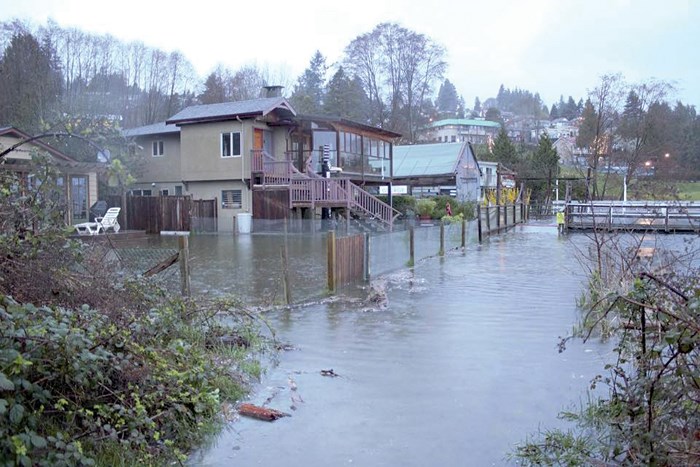Strong winds and high tides wreaked havoc on the Sunshine Coast last week as volunteer firefighters responded to 23 separate 911 calls within 15 hours.
Winds surged to almost 40 km an hour between 7 p.m. on March 9 and noon on March 10, felling trees and power lines. At the peak of the storm, around midnight on March 9, BC Hydro reported 7,000 customers on the Coast were without power.
Firefighters got the majority of calls for service from residents worried about downed lines and potential fires, resulting in fire halls sending out their volunteers repeatedly throughout the evening.
Ryan Daley, fire chief at the Halfmoon Bay department, said his volunteer firefighters attended six calls during the 15-hour storm period.
“We got lots of calls about wires down – we even had a telephone pole down with a transformer across the highway by Wood Bay,” Daley said.
“Because BC Hydro’s so busy, it’s an emergency call because wires could be live and if they are we have to keep the public 30 metres back or we could have a fatality, very easily.”
Daley said the calls for service kept his firefighters busy all night long and he hopes the community appreciates the dedication and service firefighters on the Coast provide.
Around midnight on March 9, the Sechelt Volunteer Fire Department responded to a call on Binnacle Avenue involving a live wire ripped from the side of a house by a fallen tree and arching electricity onto the roof.
“It was like a welder and it started the roof on fire,” Sechelt fire chief Bill Higgs said, noting it was one of his members that noticed the problem before the homeowners did.
“So we got a real jump on it.”
Even with the advance notice, once the department arrived on scene the live wire had caused a fire to burn through the roof and the attic had ignited.
“Our crews got there and got it knocked down, but it was really a strange call because the tree was still hanging overtop of the house – it hadn’t quite fallen down – and it had this wire all wrapped in it,” Higgs said.
“So we had the house on fire and the wind blowing at 40 km an hour and we had the fire to deal with and we couldn’t really be very aggressive with it because the power on the wire was still arching, so we had to find a way to get the fire knocked down without putting too much water on it because we could get ourselves electrocuted.”
His firefighters used Class A foam to get the blaze under control and soon BC Hydro arrived on scene to cut the power, enabling the firefighters to finish their work with water.
By the early morning of March 10, the storm had not relented and the downed power line across the highway in Wood Bay was blocking traffic to and from Pender Harbour.
A bus transporting students to Pender Harbour Secondary ended up being rerouted and told to take kids back home after the principal of the school notified parents of the problem that took BC Hydro several hours to rectify.
The storm’s impact was worsened in Gibsons on March 10 when the storm surge combined with a high tide of 4.8 metres (15.7 feet), forcing water over the seawalk in the area between Winegarden Park and Gibsons Marina.
The seawalk is maintained by the Town, and is built over the sewer system right-of-way.
Town CAO Emanuel Machado told Coast Reporter, “The public infrastructure, including the seawalk and the sewer line itself, experienced little or no damage.”
Machado said some private homes likely suffered water inundation, but the Town didn’t have details.
Machado also said water build-up in the trench works around the Gibsons Public Market construction site wasn’t related to the storm surge or the tide. “What you saw there was just the accumulation of heavy rain on site,” he explained.
Pictures on a Facebook group dedicated to issues in the Gibsons area prompted comments about the implications for the potential George Hotel project, which would be built near where the flooding was worst.
Machado cautioned against drawing any connections between what happened during the storm, and the risks of development on the waterfront.
“Our policies, starting with the Official Community Plan and the building bylaw, already account for sea-level rise,” he said. “So the requirement for developments [is that they] have to build their flood construction level to meet the new requirements of the province... The George, as an example, their submission already included those considerations.”



